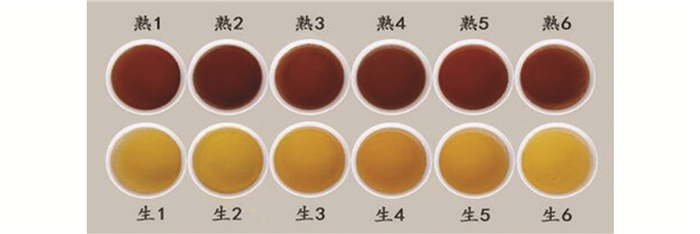-
普洱茶是以云南大叶种(Camellia sinensis (Linn.) var. assamica (Masters) Kitamura)晒青毛茶为原料,采用特定的加工工艺制成的具有独特品质特征的茶叶.按其加工工艺及品质特征的不同,将普洱茶分为普洱生茶和普洱熟茶两种类型[1].普洱生茶由晒青毛茶经蒸压成型干燥制得,普洱熟茶是晒青毛茶在高温高湿和微生物参与的条件下,经渥堆后发酵制得.
早在20世纪90年代就开展了普洱茶生化成分的研究[2],罗龙新等[3]发现普洱茶在渥堆结束后,茶多酚、儿茶素、茶黄素、茶红素、氨基酸和可溶性糖的质量分数均显著下降,茶褐素和水不溶性茶多酚明显增加.当前对普洱茶的研究侧重于营养功效[4-5]、特征性香气的组成[6-7]、渥堆发酵中菌种的筛选、分离与鉴定[8]以及普洱茶年份的鉴定等[9],但鲜有文献[10-11]分析比较生茶和熟茶.鉴于生茶和熟茶的品质差异以及其广阔的市场前景,所以对普洱生茶和熟茶的品质化学成分进行比较和研究具有重要意义.
本文以云南地区代表性的普洱生茶和熟茶为研究对象,通过传统感官审评对其汤色、滋味进行评价,采用分光光度计、高效液相色谱(high performance liquid chromatography,HPLC)和UltraScan Pro测色仪等,分析比较生茶和熟茶的主要生化成分及色差的差异;并结合相关性研究,分析获得与普洱生茶和熟茶的色泽、滋味相关的主要生化成分.旨在科学评价普洱生茶和熟茶的品质特性,理性指导普洱生茶和熟茶的加工.
全文HTML
-
FA1004电子天平,上海舜宇恒平科学仪器有限公司;BPG-9070A精密鼓风干燥箱,HWS-26电热恒温水浴锅,上海一恒科学仪器有限公司;LC-20高效液相色谱仪,UV-2450紫外可见分光光度计,日本岛津公司;722可见分光光度计,上海菁华科技仪器有限公司;5810台式高速冷冻离心机,德国Eppendorf公司;UltraScan Pro测色仪,上海信联创作电子有限公司;KQ5200DE超声波振动仪,江苏昆山市超声仪器有限公司.
-
选取和搜集云南地区普洱生茶和熟茶样品共12个,购于云南大益公司和云南下关沱茶公司,是云南地区极具代表性的传统名茶,是目前销量规模最大、市场覆盖最广、影响力度最大的生茶和熟茶,见表 1.
-
福林酚、甲醇、冰乙酸、碳酸钠、三氯化铝、水合茚三酮、氯化亚锡、磷酸氢二钠、磷酸二氢钾、蒽酮、硫酸、正丁醇、95%乙醇、乙酸乙酯、碳酸氢钠、草酸,重庆永捷实验仪器有限公司;咖啡碱、谷氨酸、葡萄糖、表没食子儿茶素(Epigallocatechin,EGC)、儿茶素(Catechin,C)、表没食子儿茶素没食子酸酯(Epigallocatechin Gallate,EGCG)、表儿茶素(Epicatechin,EC)、没食子儿茶素没食子酸酯(Gallocatechin gallate,GCG)、表儿茶素没食子酸酯(Epicatechin gallate,ECG)、水杨酸、原儿茶酸、绿原酸、对羟基肉桂酸、咖啡酸、没食子酸(标准品),成都普瑞法科技开发有限公司;山奈酚、槲皮素、杨梅素(标准品),Sigma公司.
-
水分:按GB/T 8304-2013进行测定;
水浸出物:按GB/T 8305-2013进行测定;
氨基酸总量:按GB/T 8314-2013进行测定;
可溶性总糖:蒽酮—硫酸比色法;
茶多酚:福林酚法,按GB/T 8313-2008进行测定;
茶色素:系统分析法[12].
-
儿茶素和咖啡碱提取方法:按《GB/T 8313-2008茶叶中茶多酚和儿茶素类质量分数的检测方法》进行提取;检测方法参照文献[13]进行测定.
-
黄酮醇类物质的提取方法:取1.0 g粉碎茶样加入40 mL甲醇和4 mL盐酸,85 ℃回流提取1.5 h,过滤定容到50 mL容量瓶中,过膜待测;检测方法参照文献[14]进行测定.
-
酚酸物质提取方法:取1.0 g粉碎茶样,加入提取液(V甲酸:V甲醇=5:95) 15 mL,室温提取2 h,再超声提取30 min,定容到25 mL容量瓶中,过膜待测;检测方法参照文献[15]进行测定.
-
审评方法按照GB/T 22111-2008进行审评.
-
称取5.0 g干茶,加沸蒸馏水240 mL冲泡5 min,趁热减压过滤,滤液冷却至室温25 ℃后定容至250 mL备用.使用UltraScan Pro测色仪测量茶汤色差L*,a*,b*值.
-
数据均采用DPS v7.05版软件进行运算;样本间的差异显著性检验采用Duncan法;相关性分析采用Pearson相关分析法.
1.1. 仪器与设备
1.2. 材料与方法
1.2.1. 材料
1.2.2. 主要试剂
1.3. 方法
1.3.1. 生化成分测定方法
1.3.1.1. 主要生化成分测定
1.3.1.2. 儿茶素单体和咖啡碱质量分数测定
1.3.1.3. 黄酮醇质量分数测定
1.3.1.4. 酚酸质量分数测定
1.3.2. 感官审评
1.3.3. 茶汤色差测定[16]
1.4. 数据分析
-
生茶和熟茶的汤色、滋味感官审评结果,见表 1和图 1.由表 1和图 1可知,生茶和熟茶的汤色、滋味差异较大.生茶汤色橙黄明亮,似琥珀色,熟茶汤色红浓(褐)明亮;生茶滋味醇和,熟茶滋味则更加醇厚回甘.普洱生茶和熟茶品质特征的不同,是由于不同加工工艺引起的生化成分差异导致的,下文将进一步从两者的生化成分差异来分析生茶和熟茶的感官审评差异及其缘由.
-
由表 2可知,生茶和熟茶的水浸出物和游离氨基酸总量差异有统计学意义,可溶性总糖和咖啡碱质量分数差异无统计学意义.
水浸出物是茶叶中所有溶于热水的可溶性物质的总称,是茶汤的主要呈味物质[17].由表 2可知,生茶的水浸出物质量分数显著高于熟茶,平均质量分数分别为41.725%和34.935%,生茶水浸出物比熟茶高6.79%.由此可见,生茶的水溶性内含成分更多,茶汤拥有的呈味物质更多.
游离氨基酸是构成茶叶品质尤其是绿茶茶汤滋味的重要成分,能增进茶叶的鲜爽味[18].吕海鹏等[19]研究发现,普洱熟茶中的游离氨基酸总量与滋味品质的相关性最强,为-0.806.由表 2可知,生茶的游离氨基酸总量显著高于熟茶,平均质量分数分别为2.994%和1.499%,生茶游离氨基酸总量比熟茶高1.495%,所以生茶滋味较之熟茶更为鲜爽.熟茶的氨基酸在渥堆发酵的特殊温湿条件下发生氧化、降解和转化,被微生物作为氮源营养利用[3],所以质量分数较低,滋味更为醇厚.
可溶性总糖是茶汤甜味的主要生化成分,能缓解茶汤的苦涩味和刺激性[18].生茶可溶性总糖质量分数略高于熟茶,分别为4.527%和3.799%.咖啡碱是茶叶中主要的嘌呤碱,是茶汤重要的滋味物质[18].生茶的咖啡碱质量分数略低于熟茶,分别为3.576%和3.707%.虽生茶和熟茶的可溶性总糖和咖啡碱质量分数差异无统计学意义,但这两种物质可能与其他生化成分发生作用,对普洱茶品质产生影响,如咖啡碱易与蛋白质结合形成冷后浑影响茶汤汤色等[20].
-
茶多酚是形成普洱茶品质的重要活性物质,在茶汤中呈苦涩味,有较强的刺激性[18],其中质量分数较高、研究较多的是EGCG,C,ECG,EGC,GCG,EC这6种儿茶素.
由表 3可知,生茶的茶多酚以及各儿茶素单体质量分数均显著高于熟茶,其中EGCG和酯型儿茶素的差异最为显著.生茶EGCG质量分数是熟茶的216.32倍,其质量分数分别为79.065 mg/g和0.366 mg/g;生茶酯型儿茶素质量分数是熟茶的112.17倍,其质量分数分别为136.617 mg/g和1.218 mg/g.在儿茶素组成中,生茶以酯型儿茶素为主,质量分数为136.617 mg/g,占儿茶素的65.79%;熟茶以非酯型儿茶素为主,质量分数为2.676 mg/g,占儿茶素的68.72%.酯型儿茶素收敛性较强,苦涩味较重;非酯型儿茶素收敛性较弱,苦涩味较轻[21];所以生茶的滋味更加强烈,而熟茶滋味则更加醇和.
-
茶黄素、茶红素和茶褐素是普洱茶主要的色素物质,是茶多酚主要的水溶性氧化物[22].
由图 2可知,茶红素和茶褐素在生茶与熟茶之间差异有统计学意义,但茶黄素差异无统计学意义.生茶和熟茶的茶红素平均质量分数分别为3.978%和1.159%,生茶是熟茶的3.432倍;生茶和熟茶的茶褐素平均质量分数分别为2.549%和9.190%,熟茶是生茶的3.605倍;生茶茶黄素质量分数略高于熟茶,其平均质量分数分别为0.120%和0.116%.茶黄素是茶汤“亮”的主要成分,在口味上具有强烈的收敛性,味感辛辣;茶红素呈棕红色,也具有较强的刺激性和收敛性,但比茶黄素弱;茶褐素是茶汤“褐”的主要成分,使茶汤滋味变淡[22;23].生茶的茶黄素和茶红素质量分数高于熟茶,所以生茶茶汤橙黄明亮,滋味更强烈;而熟茶茶褐素质量分数极显著高于生茶,所以熟茶汤色红褐,滋味更醇和.
-
茶叶中的黄酮醇易糖苷化,通常以糖苷形式存在,常见的黄酮醇苷的非糖苷部分有槲皮素、山奈酚和杨梅素,对黄酮醇苷进行水解,再利用HPLC可检测茶汤中槲皮素、山奈酚和杨梅素的质量分数.黄酮醇及苷类的水溶液为绿黄色,对茶叶汤色和滋味等感官品质有较大影响[24].
由图 3可知,生茶和熟茶的黄酮醇质量分数差异有统计学意义.生茶和熟茶的槲皮素平均质量分数分别为3.618 mg/g和2.348 mg/g,生茶是熟茶的1.541倍.生茶和熟茶的杨梅素平均质量分数分别为0.702 mg/g和0.515 mg/g,生茶是熟茶的1.363倍;生茶和熟茶的山奈酚平均质量分数分别为1.452 mg/g和0.824 mg/g,生茶是熟茶的1.762倍. 3种黄酮醇中槲皮素质量分数最高,分别占生茶和熟茶黄酮醇总量的62.68%和63.68%.黄酮醇易糖苷化,通常以糖苷形式存在,林杰等[25]对红茶进行研究发现,黄酮醇苷类物质阈值低,是红茶中主要的涩味物质. Wang L F等[26]对绿茶茶汤中的3种黄酮醇进行研究发现,槲皮素与茶汤色泽、与红绿度相关性明显.生茶的3种黄酮醇质量分数均高于熟茶,所以生茶具有的涩味更强,收敛性更强,汤色也更为黄亮;熟茶经过渥堆发酵,3种黄酮醇质量分数降低,苦涩味下降,滋味趋于醇和,汤色转化为红浓明亮.
-
酚酸的存在形式复杂,主要以酯键、糖苷键等与其他物质相结合的方式存在,游离态很少.酚酸与食品色泽、感官品质密切相关,影响着食品的风味、收敛性和硬度[27].其中质量分数较高、研究较多的酚酸有水杨酸、原儿茶酸、绿原酸、对羟基肉桂酸、咖啡酸和没食子酸.
由表 4可知,生茶和熟茶的水杨酸、原儿茶酸、绿原酸、对羟基肉桂酸、咖啡酸和没食子酸质量分数差异均有统计学意义.生茶的原儿茶酸、绿原酸、对羟基肉桂酸和咖啡酸质量分数均显著高于熟茶;熟茶的水杨酸和没食子酸质量分数均显著高于生茶.熟茶酚酸总量显著高于生茶,熟茶和生茶的酚酸总量分别为10.558 mg/g和7.209 mg/g,熟茶是生茶的1.465倍.没食子酸和水杨酸是所检测的酚酸中质量分数最高的两种物质,熟茶和生茶的没食子酸平均质量分数为7.806 mg/g和5.065 mg/g,熟茶是生茶的1.541倍;熟茶和生茶的水杨酸平均质量分数为2.219 mg/g和0.916 mg/g,熟茶是生茶的2.422倍.较之熟茶,生茶本身所具有的茶多酚更多,酚酸物质能增进茶汤的收敛性和苦涩味,所以生茶滋味更强烈,收敛性和苦涩味更强;但是,酚酸又作为一种呈色物质[28],在熟茶中质量分数更高,所以熟茶汤色更深更为红褐.
-
生茶和熟茶的色差分析结果,见图 4. L*代表茶汤的明亮度,生茶和熟茶分别为10.224和10.077,生茶茶汤明亮度略高于熟茶,差异无统计学意义. a*代表红绿度,生茶和熟茶的a*值都为正,分别为0.952和0.386,偏红,且生茶a*值显著高于熟茶. b*代表黄蓝度,生茶和熟茶的b*值都为正,分别为1.982和0.462,偏黄,且熟茶b*值显著高于生茶.由于茶叶色差是多种物质的综合作用,生茶和熟茶的色差差异明显,在一定程度上也反映出生茶和熟茶品质的差异.
-
生茶和熟茶的生化成分与色差、汤色和滋味的感官审评得分相关性结果,见表 5.
与生茶明亮度L*呈显著相关的成分有GCG、茶红素、茶色素总量和对羟基肉桂酸,相关系数分别为0.78,-0.79,-0.85和-0.85;而与熟茶明度L*呈显著相关的成分有绿原酸、对羟基肉桂酸和咖啡酸,相关系数为-0.80,-0.80和-0.84.与生茶a*呈显著相关的成分仅ECG,相关系数为0.81;而与熟茶a*呈显著相关的成分有绿原酸、对羟基肉桂酸和咖啡酸,相关系数-0.82,-0.77和-0.80.与生茶b*呈显著相关的成分有咖啡碱,C,EGC,EGCG,酯型儿茶素、儿茶素总量和酚酸总量,相关系数分别为-0.97,-0.88,-0.78,-0.83,-0.95,-0.91和-0.76;而与熟茶b*呈显著相关的成分有茶多酚、茶褐素和茶色素总量,相关系数为0.77,-0.92和-0.90.
根据上述分析,生茶色差主要受茶色素、茶多酚、儿茶素、咖啡碱以及酚酸等物质的影响,生茶茶多酚和儿茶素物质质量分数丰富,易与咖啡碱结合,通过氢键、疏水作用力等方式形成茶乳酪影响色差[20],而茶色素和酚酸物质作为呈色物质影响着生茶的色差[28].熟茶色差主要受茶多酚、儿茶素、茶色素和酚酸物质的影响,在熟茶的渥堆发酵过程中,水浸出物质量分数降低,茶多酚和儿茶素类物质被氧化、降解和转化形成茶色素和酚酸等物质,促进了熟茶品质的形成,影响着熟茶的色差.
与生茶汤色呈显著相关的成分有可溶性总糖和茶红素,相关系数分别为0.90和-0.76;与熟茶汤色呈显著相关的成分有茶多酚和咖啡酸,相关系数分别为0.77和-0.81.在感官审评中,汤色得分根据茶汤综合体现的明亮或浑浊打分,相关性分析表明,生茶可溶性总糖质量分数越高,生茶汤色得分越高,而熟茶的茶多酚质量分数越高,熟茶汤色得分越高.
与生茶滋味呈显著相关的成分仅没食子酸,相关系数为-0.77;与熟茶滋味呈显著相关的成分有绿原酸、对羟基肉桂酸和咖啡酸,相关系数分别为-0.87,-0.88和-0.90.在感官审评中,滋味得分根据茶汤滋味的浓淡和回甘打分,相关性分析表明,生茶和熟茶的滋味得分都受到酚酸物质的影响.由此可见,酚酸物质与普洱茶的品质风味密切相关,有待进一步研究.
-
由表 6可知,生茶汤色与明度L*呈显著正相关,相关系数为0.84;生茶滋味与红绿度a*呈显著负相关,与黄蓝度b*呈显著正相关,相关系数分别为-0.85和0.80.由表 7可知,熟茶汤色与L*和a*呈极显著正相关,相关系数为0.91和0.90;熟茶滋味与L*和a*也呈极显著正相关,相关系数为0.88和0.95.无论生茶和熟茶,茶汤汤色都与明度L*值呈现显著或极显著正相关,所以茶汤色差分析能在一定程度上反映出茶叶品质水平,因此普洱生茶和熟茶的色差测定可以作为评价茶叶品质的手段之一.
2.1. 汤色滋味感官审评
2.2. 生茶和熟茶的生化成分比较分析
2.2.1. 主要生化成分质量分数比较分析
2.2.2. 茶多酚、儿茶素单体比较分析
2.2.3. 茶色素比较分析
2.2.4. 黄酮醇比较分析
2.2.5. 酚酸比较分析
2.3. 生茶和熟茶的色差比较分析
2.4. 生化成分与色差、汤色和滋味的相关性分析
2.5. 色差与汤色、滋味的相关性分析
-
本试验以云南地区代表性普洱生茶和普洱熟茶为研究对象,经测定分析得出以下结论:
普洱生茶和熟茶,由于采用不同的加工工艺,品质特征不同,生化成分差异大,在测定的23种生化成分中,除可溶性总糖、咖啡碱和茶黄素外,生茶和熟茶的水浸出物,游离氨基酸总量,C,EC,ECG,EGC,GCG,EGCG,茶多酚,茶红素,茶褐素,杨梅素,山奈酚,槲皮素,水杨酸,原儿茶酸,绿原酸,对羟基肉桂酸,咖啡酸,没食子酸等20种物质的质量分数差异有统计学意义.
经色差分析发现,生茶和熟茶的色差差异明显,生茶a*值显著高于熟茶,熟茶b*值显著高于生茶,但L*值差异无统计学意义.
经相关性分析发现,普洱生茶和熟茶的品质风味与茶多酚和酚酸物质密切相关,尤其是酚酸物质,有待进一步研究.其中生茶色差与茶色素、茶多酚、儿茶素、咖啡碱以及酚酸物质显著相关,熟茶色差与茶多酚、儿茶素、茶色素和酚酸物质显著相关;生茶汤色得分与可溶性总糖显著正相关,熟茶汤色得分与茶多酚显著正相关;生茶滋味得分与没食子酸显著负相关,熟茶滋味得分与绿原酸、对羟基肉桂酸和咖啡酸显著负相关.




 下载:
下载:


